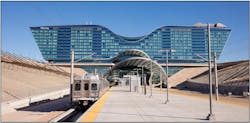After nearly five years in the making, the 36-mile Eagle P3 project in Denver — the nation’s first public-private partnership (P3) for commuter rail — is opening its new commuter lines to the public. The 23-mile University of Colorado A Line is the first of three project segments, which opened in April 2016. Running between downtown Denver Union Station and Denver International Airport (DIA), the trip now takes about 35 minutes — nearly half the original drive time in heavy traffic.
On April 22, 2016, the Denver Regional Transportation District (RTD) opened the new 23-mile line that connects DIA to Union Station downtown. The two remaining Eagle P3 segments will open by fall of 2016, connecting downtown with the neighboring suburbs to the west and the north.
The Eagle P3 project is part of RTD’s multi-billion-dollar FasTracks Program that is scheduled to add more than 120 miles of commuter rail and light rail tracks, 18 miles of bus rapid transit (BRT), and 21,000 parking spaces at rail and bus stations throughout Denver’s eight-county regional transit district.
Innovative Collaboration
The Eagle P3 project is using the P3 financing and delivery approach for transit line design, build and operation. With a partnership agreement between a public agency and a private sector entity, the private sector assumes some of the risks associated with the delivery of new infrastructure, which reduces overall costs and expedites the project completion schedule. The return on investment for a P3 is also greater compared to traditional methods.
Denver Transit Partners (DTP) is a private consortium led by the Fluor Corp. that entered into a 34-year agreement with RTD, for the 5-year design and build of the Eagle P3 project, followed by 29 years to operate and maintain the system. DTP is comprised of a partnership between Fluor, Denver Rail (Eagle) Holdings Inc., and Aberdeen Infrastructure Investments (No. 4) USA LLC.
The portion of the DTP team that holds the $1.2 billion contract to design and construct the commuter rail system is Denver Transit Constructors (DTC), a joint venture between Fluor, Balfour Beatty Rail Inc. and Ames Construction. The partnership led the design-build of the Eagle P3 project, with design work beginning in 2010. "We’ve completed several large design-build projects with Fluor," said Tom Flick, Ames Construction’s Rocky Mountain region vice president, design-build. "Because of our established regional headquarters and strong civil construction capabilities in Denver, Ames led the civil construction portion of the design-build effort for the DTC team."
The design-build contract included construction of three new double-track electric commuter rail lines totaling 36 miles, 14 miles of new freight rail track work, 32 bridges, 30 at-grade crossings, 14 stations with park-n-ride lots, and a major vehicle maintenance facility. The A Line is the longest Eagle P3 line. Two additional lines run north and west from downtown to Westminster, Arvada and Wheat Ridge.
Although commuters in the Denver metro area have been using light rail for years, the trains on the A Line are not light rail vehicles. Because the line to DIA runs next to a freight corridor, the government required heavier, commuter rail vehicles. Reaching top speeds of 79 mph, the new rail cars are a first-of-their-kind in Denver, offering level boarding for greater accessibility and capacity to carry up to 200 passengers.
Navigating the 36-Mile-Long Work Zone
Ames Construction’s workers were spread throughout the 36-mile-long work zone, which resulted in some of the biggest construction challenges to be logistical. A project of this scale and scope required skillful coordination as various teams worked on different portions of the project along the vast construction corridor.
At the same time, jurisdictional issues commanded attention to ensure forward progress. Multiple agencies had approval and inspection authority since the project passes through five cities and parallels both the Union Pacific and BNSF railroads. Open and constant communication with every entity was critical to achieve significant milestones.
Ames crews started construction in January of 2011 and the last bridge deck for the project was poured by Ames civil crews in September 2015. The final phase included testing of the train vehicles and the integrated system of train control, including at-grade intersections with gates, signals, automobile traffic signals, communications, and active train control (ATC) and positive train control (PTC). Remaining civil work in 2016 is primarily on the last remaining station Park-n-Ride lots.
In the early 1990s, Ames Construction was the first, and largest, civil contractor on the site of the current DIA, performing multiple contracts for its completion. As part of the original vision for regional development, Ames also worked to complete the central core rail project in downtown Denver. With the completion of the new rail that closes the loop between downtown and the airport, the two previous Ames projects will finally connect.
Safety “Above and Beyond”
Safety is the priority every day and on every project to protect both workers and the public. Given the complexity and number of workers on the Eagle P3 Project — reaching a combined workforce exceeding 1,000 employees during peak construction — it was particularly gratifying for the project to receive a 2014 VPP award from OSHA. OSHA’s Voluntary Protection Program (VPP) recognizes individual companies and worksites that implement comprehensive, effective workplace safety and health programs for their employees that go beyond required OSHA standards. This esteemed recognition has been awarded to only 0.03 percent of America's workplaces.
Commitment to the Future
The P3 method for project delivery requires a long-term commitment for operation and maintenance after construction, and success of the Eagle P3 to reach financial close reflects critical executive-level support and leadership. "This project is an outstanding example of how the private and public sectors can partner to deliver infrastructure projects on time and within budget," said David Seaton, Fluor’s chairman and chief executive officer in a recent press release. That same leadership and commitment will drive how the Eagle P3 operates for decades to come.
Susan Carter is a writer with Ames Construction.
